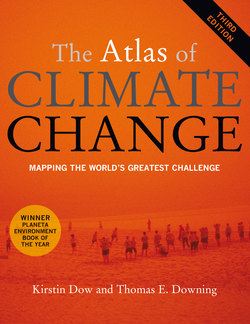Читать книгу The Atlas of Climate Change - Professor Kirstin Dow - Страница 12
На сайте Литреса книга снята с продажи.
Оглавлениеbecoming more apparent, and not just to scientists but to people in their daily lives. Residents in parts of Alaska have already experienced warming of up to 4°C. They have seen buildings subside as the ground beneath them thawed for the first time in memory. Old photographs retain the images of glaciers, seemingly invulnerable, that are now gone. Around the world, the predictions of climate change – that we would much rather dismiss – are now all too obvious. The backdrop of climate policy has changed dramatically in the past five years. Decades of economic growth and stability (for some) have been overturned with global recession, shrinking budgets and volatile markets. As we write, European governments are contemplating a second $100 billion bailout of Greece in hopes of stabilizing the Euro-zone and avoiding a cascade of defaults that could capture Ireland, Portugal, Spain, and even Italy. While commitments for development assistance and climate change are by and large protected, no one believes major new and additional funding for climate change will be easy to mobilize. Financial crisis has clear impacts on real people, across the world. The vision of our connected world captured at the Rio Earth Summit in 1992 seems more dangerous. In this edition, we include a new spread based on the limits of prediction and responses. The conjuncture of shocks in biogeophysical processes (often referred to as tipping elements), fragility in governance and large-scale impacts could have alarming consequences. For instance, collapse of the West Antarctic Ice Sheet and deglaciation of Greenland would raise sea levels by some 12 meters. Retrenchment of poverty and civil strife in poor countries would swamp nascent efforts to avoid additional climate impacts. Population displacement due to climate-related disasters, sea-level rise, and collapse of regional production systems destabilizes governments and accelerates vulnerability. Climate as an issue of security has gained the attention of several forums. Not all climate-related changes will be negative! The Arab Spring, in some ways related to high food prices and the impacts of climate extremes, caught us by surprise. Greater awareness of climate change is leading to new opportunities for development too. Action is gaining ground, but is hardly adequate The changes already in evidence severely challenge environmental management and international governance. As we approach Rio +20, we still lack effective agreements to stabilize the level of greenhouse gases in the atmosphere and to protect the most vulnerable populations. Commitments under the Kyoto Protocol and the more recent round of voluntary targets are only the beginning of the 60 percent to 80 percent reductions required. Dependence on fossil fuels is deeply embedded in our economies and political regimes. Higher oil prices have sparked a boom in shale oil, and pushed forward more hazardous technologies. It seems we are going to have to make decisions to limit fossil-fuel use rather than rely on prices or peak oil to achieve drastic reductions. At the same time, the Deepwater Horizon and Fukushima disasters have pushed many people and some governments to promote renewable energy. Globalization, with its impacts on industrial location, economic development, and extensive transport demands, is influencing future patterns of emissions. Negotiating reductions is complicated by the combination of historical versus anticipated contributions associated with economic development, and export relations that result in one country producing goods and emissions for markets in another. Climate change is as much a humanitarian and human development concern as it is an environmental one. The most vulnerable populations are not the people driving climate change. Of those living on less than a dollar a day, few have electricity, cars, refrigerators, or water heaters. But, because their lives are tied to climate conditions and they have few resources to buffer against bad or progressively difficult conditions, they are likely to bear the highest human costs. It is encouraging to see approaches based on human rights continue to be influential in negotiations. Connections are also being made between adaptation and mitigation. The cost of responding to disasters may mean cutting other budgets. New Orleans cut funding for education, police, social, legal, and other services after Hurricane Katrina. In the UK, assistance for peacekeeping and humanitarian emergencies is 10 percent of official development assistance. Even wealthy, well prepared countries will face trade-offs between action at home and abroad, between risk reduction and emergency responses, and possibly between adaptation and mitigation. Responding to climate change and the threatened consequences is a serious and sobering business, but it is not hopeless, nor are all foreseeable outcomes inevitable. There are feasible, effective solutions. Many of these actions save money and make good sense for other reasons as they also address the broader issues of sustainability through reducing dependency on increasingly scarce petroleum supplies, cutting air pollution, and preserving the ecosystems that help maintain the ecological processes we rely on. Although it is tempting to focus on technological solutions, it is essential also to address the issues of consumption and lifestyle that drive technologies. Technological change alone cannot achieve the necessary levels of emissions reductions; many currently available technologies can, however, make a substantial difference. Renewable energy technologies are becoming more diverse, affordable, and widely adopted. These
12
